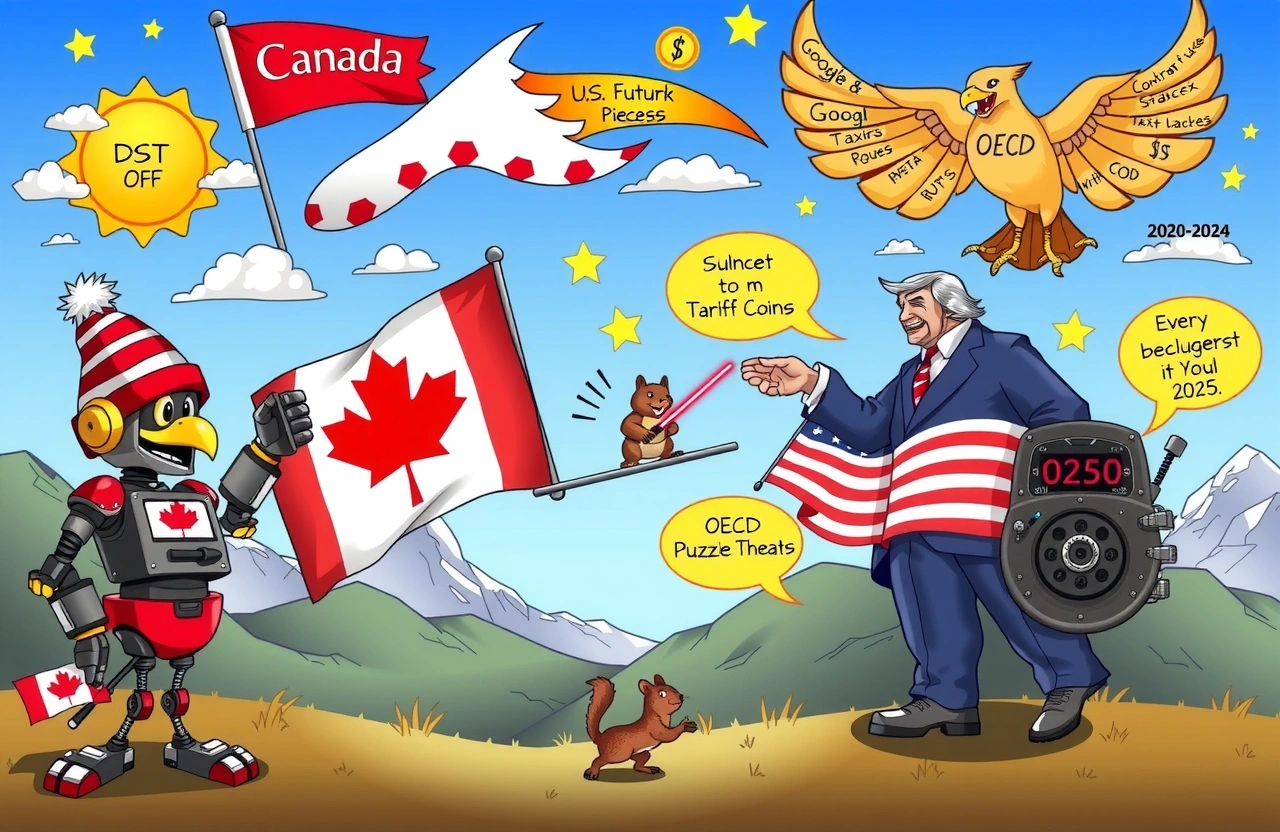In a significant policy reversal, Canada has agreed to withdraw its controversial digital services tax, removing a major obstacle to renewed trade negotiations with the United States. The June 29 announcement from Canada’s Department of Finance confirms the country will scrap the levy targeting global tech giants, signaling a diplomatic thaw between the neighboring nations. This strategic concession comes after months of escalating tensions, with Washington threatening retaliatory tariffs over what it deemed discriminatory taxation. The breakthrough paves the way for comprehensive trade discussions aimed at concluding a mutually beneficial agreement by July 2025. As both countries prepare for high-stakes negotiations, this move represents a calculated gamble by Ottawa to prioritize economic stability and cross-border cooperation amid shifting global tax landscapes. The decision to withdraw the digital services tax underscores Canada’s commitment to finding multilateral solutions while protecting its national interests in the digital economy.
The Genesis of Canada’s Digital Services Tax
Canada’s digital services tax (DST) emerged in 2020 as a stopgap measure to address growing concerns about tax avoidance by multinational technology corporations. Designed as a 3% levy on revenue generated from Canadian users of digital interfaces and data-driven services, the tax targeted companies with global revenues exceeding €750 million and Canadian digital service revenues over $20 million CAD. This legislative initiative aimed to capture tax revenue from tech behemoths like Google, Meta, and Amazon that legally minimized tax obligations through complex international structures.
Addressing the Digital Taxation Gap
The DST sought to rectify what policymakers viewed as an outdated international tax framework ill-equipped for the digital age. Traditional tax rules based on physical presence allowed digital giants to operate profitably in Canada while paying minimal corporate taxes. Key features of the tax included:
– Application to online marketplaces, social media platforms, and digital advertising services
– Revenue-based rather than profit-based calculation methodology
– Retroactive application to revenues earned since January 2022 upon implementation
Canada’s approach mirrored similar unilateral measures adopted by the UK, France, and India, reflecting global frustration with the slow pace of multilateral tax reform. Finance Minister Chrystia Freeland (方慧兰) initially defended the tax as a necessary interim solution, stating it would ensure “tech giants pay their fair share” until a comprehensive international agreement could be implemented.
International Backdrop and OECD Negotiations
Canada’s DST unfolded against protracted negotiations at the Organisation for Economic Co-operation and Development (OECD) to establish a global minimum corporate tax rate and revised profit allocation rules. The two-pillar framework, endorsed by over 130 countries in 2021, aimed to:
1. Ensure multinationals pay a minimum 15% tax rate in each jurisdiction they operate
2. Reallocate taxing rights to market jurisdictions for large profitable companies
Despite broad consensus, implementation delays prompted Canada to proceed with its domestic tax as a temporary bridge toward the OECD solution. The Canadian government maintained that the DST would be repealed once the multilateral agreement took effect, positioning it as an insurance policy against further international stagnation.
Mounting US Opposition and Trade Tensions
The digital services tax quickly became a flashpoint in US-Canada relations, with Washington launching an aggressive campaign against what it characterized as discriminatory trade practices. The Office of the United States Trade Representative (USTR) initiated a Section 301 investigation in 2020, concluding that the DST unfairly targeted American technology firms that dominate the digital services sector.
Retaliation Threats and Economic Pressure
Former President Donald Trump (特朗普) authorized potential retaliatory tariffs of up to 25% on approximately $3.6 billion worth of Canadian exports, targeting key sectors including:
– Agricultural products like beef, pork, and maple syrup
– Industrial goods such as aluminum and machinery
– Consumer items ranging from footwear to chocolate
The Biden administration maintained this hardline stance, with USTR Katherine Tai (戴琪) warning in 2023 that the US would “not hesitate to use all available tools” to challenge digital service taxes that singled out American companies. This pressure created significant economic uncertainty for Canadian exporters already navigating supply chain disruptions and inflationary pressures.
Diplomatic Stalemate and Economic Costs
Bilateral relations reached an impasse as Canada refused to suspend its DST without guarantees of OECD implementation, while the US demanded unconditional withdrawal before considering any trade concessions. This deadlock threatened to derail broader cooperation on issues including:
– Continental energy security
– Critical minerals supply chains
– Border infrastructure modernization
Industry groups on both sides sounded alarms about potential collateral damage. The Business Council of Canada estimated that US tariffs could cost the Canadian economy up to $3.5 billion annually, while the US Chamber of Commerce warned of inflationary impacts on American consumers and supply chains.
The Breakthrough: Canada Withdraws Digital Services Tax
The June 29 agreement represents a carefully negotiated compromise that allows both nations to claim diplomatic victories. Canada’s decision to withdraw the digital services tax removes the immediate threat of US tariffs while preserving Ottawa’s commitment to fair taxation principles through multilateral channels.
Terms of the Agreement
Domestic Legislative ProcessFinance Minister Chrystia Freeland (方慧兰) will introduce repeal legislation when Parliament reconvenes, with the governing Liberal Party expected to secure sufficient support from opposition parties. The legislative roadmap includes:
– First reading of the repeal bill in fall 2024
– Committee review and potential amendments
– Final passage by spring 2025
Until formal repeal, Canada has agreed to suspend DST collection and not pursue outstanding tax assessments for covered companies. This interim approach provides certainty for businesses while the legislative process unfolds.
Renewed Trade Negotiations Framework
With the digital tax obstacle removed, both countries have committed to revitalizing trade discussions under an ambitious timeline targeting mid-2025 completion. The renewed negotiations will build upon the existing United States-Mexico-Canada Agreement (USMCA) framework while addressing emerging economic challenges.
Key Negotiation Priorities
Preliminary discussions indicate several focal points for the talks:
– Digital trade rules and cross-border data flows
– Agricultural market access and supply management systems
– Labor mobility and professional credential recognition
– Clean energy incentives and green technology standards
– Customs modernization and trade facilitation measures
A senior Canadian trade official involved in preparatory work noted: “The reset allows us to move beyond defensive posturing toward proactive agenda-setting in areas like AI governance and critical minerals.”
Institutional Framework and Timeline
The negotiation structure will feature:
– Principal-level talks between US Trade Representative and Canadian Minister of International Trade
– Twelve specialized working groups covering sectoral issues
– Quarterly progress assessments beginning September 2024
– Stakeholder consultation mechanisms for business and labor input
The July 2025 deadline coincides with the first scheduled review of the USMCA, creating potential synergies in addressing implementation issues and modernization priorities across the continental trade relationship.
Economic Implications and Sectoral Impacts
Canada’s decision to withdraw the digital services tax carries significant economic consequences across multiple sectors, with both immediate and long-term ramifications for businesses and consumers.
Technology Sector Consequences
The DST repeal provides immediate relief for US-based tech giants facing potential tax liabilities estimated at CAD $1.2 billion over five years. Industry responses include:
– Google announced plans to expand its Canadian AI research facilities
– Amazon committed to additional fulfillment center investments
– Microsoft pledged increased cloud computing infrastructure spending
Canadian tech companies also stand to benefit from reduced trade uncertainty. Shopify CEO Tobias Lütke welcomed the agreement, noting “stable trade relations are foundational for scaling globally competitive digital businesses.”
Export Industries and Supply Chains
Global Tax Reform ContextCanada’s withdrawal from its unilateral tax measure occurs amid uneven progress toward the OECD’s two-pillar tax framework. While pillar one (profit reallocation) faces implementation challenges, pillar two (global minimum tax) is advancing with the European Union, UK, Japan, and South Korea establishing 15% minimum rates.
Multilateral Momentum vs Unilateral Measures
The Canada-US agreement strengthens the OECD’s position by demonstrating that major economies will abandon national digital taxes in favor of the coordinated approach. Recent developments include:
– 50 jurisdictions implementing global minimum tax rules as of 2024
– Technical agreements on profit allocation rules reached in October 2023
– Developing country participation through the Inclusive Framework
OECD Secretary-General Mathias Cormann hailed Canada’s move as “a significant boost for the multilateral process that underscores the viability of our consensus-based approach.”
Outstanding Implementation Challenges
Despite progress, significant hurdles remain before the OECD framework becomes operational:
– US congressional approval required for treaty ratification
– Technical complexities in profit attribution methodologies
– Disagreements over scope thresholds and safe harbors
– Coordination with existing bilateral tax treaties
These challenges make the 2025 implementation target ambitious, though Canada’s withdrawal increases pressure on holdout countries to accelerate domestic adoption.
Strategic Considerations and Future Outlook
Canada’s decision to withdraw the digital services tax reflects a pragmatic assessment of economic priorities and diplomatic realities. The move balances several competing objectives:
Preserving the US relationship remains Canada’s paramount economic priority, given that bilateral trade exceeded $1.2 trillion CAD in 2023. By removing the DST irritant, Canada gains leverage in negotiations over more consequential issues like softwood lumber, dairy market access, and Buy American procurement policies.
Simultaneously, the Trudeau government maintains its commitment to fair taxation principles through multilateral channels. The agreement explicitly links DST withdrawal to OECD implementation, creating accountability mechanisms to ensure the global tax reform process continues advancing.
For businesses operating across the border, the resolution provides much-needed certainty after years of tax and trade policy volatility. Companies should now:
– Review cross-border pricing arrangements in anticipation of OECD rules
– Engage in government consultations on the renewed trade negotiations
– Monitor legislative developments regarding the formal DST repeal
– Assess supply chain vulnerabilities in light of renewed bilateral cooperation
The path forward remains complex, but this breakthrough demonstrates that both countries recognize their shared interest in collaborative solutions. As negotiations progress toward the 2025 deadline, stakeholders should seize this opportunity to shape a forward-looking trade architecture that supports innovation, inclusivity, and sustainable growth across North America.
Canada’s withdrawal of the digital services tax marks not an end but a new beginning—a strategic recalibration that transforms confrontation into cooperation. The coming months will test both nations’ abilities to build upon this foundation, crafting agreements that reflect evolving economic realities while preserving the world’s most consequential trading relationship. Businesses, policymakers, and citizens must now engage actively to ensure these negotiations deliver shared prosperity in the digital age.




